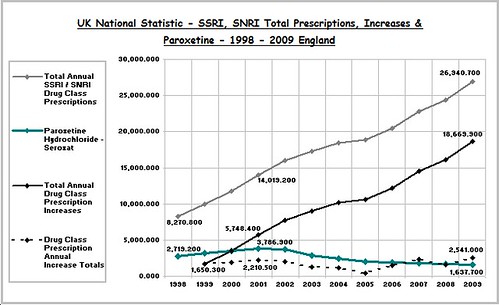Following the 2002 preannouncement of the Seroxat Group Litigation, the associated Seroxat Campaigns initiation and the generated unprecedented adverse publicity in the UK media the decline in Seroxat prescriptions accelerated - this decline has followed an exponential decay and continues to date.

Whilst the increase in total SSRI, SNRI drug class annual prescriptions of 12.92 million, over and above that reduction and the actual increase of 15.07 million for the same period, strongly indicates there is a discontinuation problem with the whole drug class.
If drugs are safe and efficacious, following an initial surge in prescriptions when a drug class is first licensed, total prescription numbers should normally plateau - as new patients are prescribed for - recovering patients are completing treatment and coming off – induction and cessation of treatments should reach a point where they approximately balance each other out.
During the period 1998 to 2009 the SSRI, SNRI drug class UK statistics show a continual median annual increases of 1.69 million in total prescriptions – adjusting this figure by omitting year 2004 with the 402 thousand increase anomaly and the addition of Seroxat prescriptions negative increase - the adjusted continual median annual increases of 2.08million in total prescriptions.
The continual median annual increases for the SSRI, SNRI drug class for the period 1998 to 2009 indicate two possible problems - either the drugs do not work and patients are not recovering … or whether they worked or not … patients are unable to discontinue the drug treatment.
In market percentage terms – market rises for the SSRI, SNRI drug class 2001 to 2009 were 92% - in 2001, Seroxats’ 3.78m share of the 14.01m total prescriptions market holding 27% - by 2009, Seroxats’ 1.63m share of the 26.94m total prescription market accounts for only 6.07%.
The official drug statistics used for these charts were sourced from the UK Government, Office for National Statistics, Department of Health, Publications and Statistics, Health care, Pharmacies and Prescriptions, Prescription Cost Analysis Statistics for England only - not the whole UK.
The inclusion of comparable data from Wales, Scotland and Northern Ireland, which collectively accounts for approximately 16.2% of the total UK population of approximately 61 million, could -- as Northern Ireland antidepressant prescription rates are twice the English per capita -- possibly increase these figures accordingly or by more than 16.2%.
(The blog will return a little later to the media coverage - in particular the role of the BBC’s program Panorama, the production team and lead journalist Shelley Jofre, the position taken by UK politicians in taking the SSRI, SNRI issue to parliament … and the legacy of ignorance left to millions of patients consuming or who went on to consume SSRI, SNRI brands other than GSK’s Seroxat.)
****
Data collection reference:
Department of Health; NHS; Prescription Cost Analysis (PCA) - England.
http://www.dh.gov.uk/en/PublicationsAndStatistics/Statistics/StatisticalWorkAreas/StatisticalHealthCare/DH_4086488

No comments:
Post a Comment